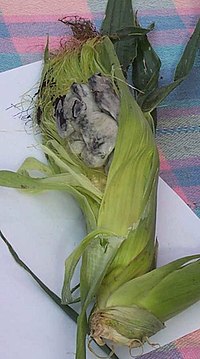
Have you ever seen corn that looked like this?
Today one of the White Oak gardeners brought several ears of corn from her garden over to H.S. for us to look at because she didn’t know what was happening to her corn. We showed the corn to our farm manager and he said, “That’s Corn Smut”. When we asked , “What’s that!” he said, it’s a fungus that happens when there has been a drought and then it starts to rain.
According to Wikipedia, Corn Smut is a pathogenic plant fungus that causes smut disease on maize and teosinte. The fungus forms galls on all above-ground parts of the corn species. Although it can infect any part of the plant it usually enters the ovaries and replaces the normal kernals of the cobs with large, distorted tumors analogous to mushrooms. The spores give the cob a burned, scorched appearance. It grows during times of drought, (like we have just been through) growing best in a 78 to 93 temperature.
Smut feeds on the corn plant and decreases the yield. Usually, smut-infected crops are destroyed. Some farmers may also choose to prepare corn silage out of the smutted corn. It is most popular in Mexico, where it is known as huitlacoche and can be regularly found as an option in meals. The consumption of corn smut originates from ancient Aztec cuisine and is still considered a delicacy in Mexico, even being preserved and sold for a significantly higher price than corn.[12] For culinary use, the galls are harvested while still immature — fully mature galls are dry and almost entirely spore-filled. The immature galls, gathered two to three weeks after an ear of corn is infected, still retain moisture and, when cooked, have a flavor described as mushroom-like, sweet, savory, woody, and earthy. Flavor compounds include sotolon and vanillin, as well as the sugar glucose.


Leave A Comment